Novartis USA – Paulo Costa one of the worst managers
A.L.F. Crime Investigation Agency (CIA) - 08.05.2008 17:35
This information campaign is dedicated to the victims of Novartis AG. Murder, fraud, corruption, animal torture, greed, exploitation... think of anything evil and you think of Novartis and its subsidiaries Ciba Vision, Syngenta, Lek, Intercell and many more.
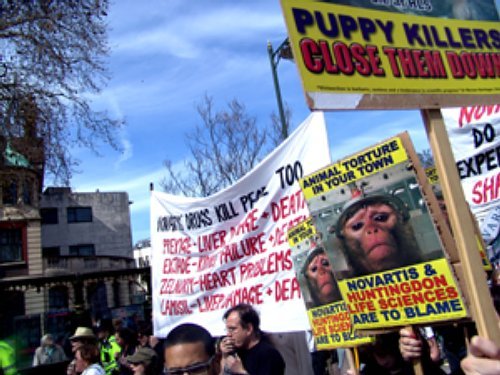
Brothers in Crime: Novartis and HLS
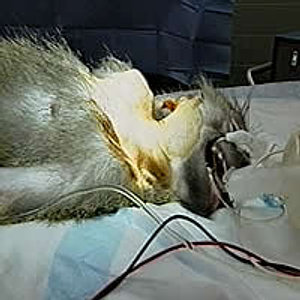
Novartis Imutran Xenotransplantation Experiment
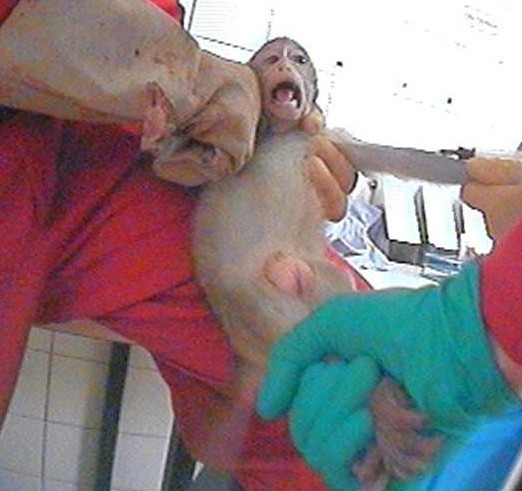
Novartis and Covance
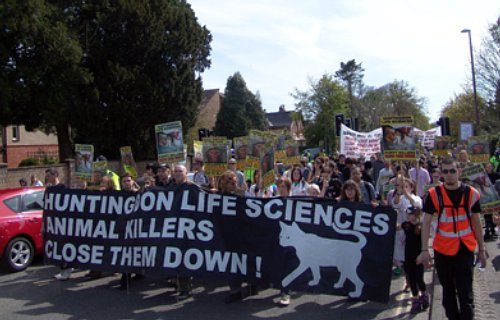
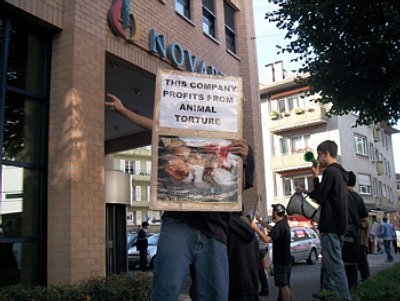
Novartis Basel, Switzerland, Torture Lab NIBR
Part 11: Novartis: PETA Names the 10 Worst CEOs for Animals in Laboratories
Despite thousands of dead animals and millions of dollars spent by Novartis and its subsidiaries to develop animal organs for transplantation into humans, the company will never be able to transplant a soul or any compassion into CEO Paulo Costa. Pointless and painful experiments in xenotransplantation—transplanting the organs of one species into another species—have been one of the greatest medical disasters of all time.
Peddling transgenic pig parts and other organs designed to replace human parts is very profitable. The fact that these transplants are prohibitively expensive, of limited value, and always deadly hasn't slowed Costa's search for an immunopig.
Six thousand people are on waiting lists for human organs; while the problem of organ shortage could largely be solved through default consent to organ donation when people die, the use of animals as warehouses for spare parts continues. One hundred years of failed research shows that animals—even if they have transplanted human genes—do not have suitable spare parts for humans. Pigs are now being genetically manipulated to carry human genes in the hope that this catalog of failure and misery can be turned into a viable form of medical treatment. Other animals—such as hamsters, rabbits, and monkeys—have also been subjected to horrific and pointless transplantation experiments. But animals were never meant to be wrecking yards for human parts. All attempts to carry out animal-to-human organ transplants have failed. These surgeries are so monumentally unsuccessful that the animals usually begin to die within minutes of receiving an organ.
In Novartis' experiments, monkeys have endured lethal infections, lethal blood clotting, bleeding complications, viral and protozoal infections, lymph cancer, severe nausea, severe stomach inflammation and diarrhea, dehydration, fatal pneumonia, persistent wound infections, breakdowns, brain trauma, heart attacks, pneumonia, and anemia. Huge doses of immune-suppressing drugs have caused internal hemorrhaging.
A swab left in a monkey's abdomen by a Novartis employee caused a lethal infection, and similar incidents occurred on a regular basis. Sometimes the hearts or kidneys would simply not function after transplantation, and some pig organs were rejected almost instantaneously, undermining the only difference between genetically modified pigs and normal pigs. Victims of these gruesome experiments were overdosed with anesthetics, and their spleens were removed. One pig's kidney was accidentally transplanted into the abdomen of a monkey, and the primate died shortly afterward. If monkeys and baboons survived surgery, they faced death by organ rejection and failure, infections resulting from drug toxicity, or severely impaired immune systems.
The danger isn't only a risk for the animals used in the experiments. Some viruses carried by animals are impossible to eradicate and can infect humans—potentially with catastrophic results, such as the deadly influenza epidemic of 1918 that killed millions of people, mad cow disease, HIV, and the recent avian flu epidemic. This threatens human patients who would receive pig organs, and scientists across the globe are concerned that these viruses may pass into the general population, causing an epidemic that could affect all of us.
Write to Costa, and let him know that Novartis' preposterous venture will never result in cures for ailing and aging humans:
Paulo Costa, CEO
Novartis Corporation
608 Fifth Ave.
New York, NY 10020
 http://www.stopanimaltests.com/f_ten_worst_ceo.asp http://www.stopanimaltests.com/f_ten_worst_ceo.asp
Here is one of the crimes committed to monkeys. Note: This research, if you can call this torture anything like that, is simply done to speed up worldwide use of cyclosporine. Most of the output is produced at Sandoz Kundl in Austria. 98% of the cyclosporine produced in Kundl is exported.
Title
Pharmacokinetics of cyclosporine in monkeys after oral and intramuscular administration: relation to efficacy in kidney allografting
H.-J. Schuurman, K. Mennninger, M. Odeh, W. Slingerland, M. Ossevoort, M. Jonker, J.-C. Hengy, B. Dorobek, J. Vonderscher, J. Ringers, H.-J. Schuurman (2001) Pharmacokinetics of cyclosporine in monkeys after oral and intramuscular administration: relation to efficacy in kidney allografting
Transplant International 14 (5) , 320–328 doi:10.1111/j.1432-2277.2001.tb00066.x
Abstract
In cynomolgus and rhesus monkeys, the dose-normalized exposure of cyclosporine administered orally as microemulsion preconcen-trate (Neoral) was lower than that upon intramuscular administration. For oral administration, mean values (± SD) of Cmax, 24-h area-under-the curve (AUC) and 24-h trough level, all normalized for a 1 mg/kg dose, were 20 ± 9 ng kg/mg ml, 210 ± 70 ng h kg/mg ml and 2.6 ± 0.9 ng kg/mg ml, respectively. For intramuscular administration, levels were about 5.5-fold, 9-fold and 22-fold higher. Based on phar-macokinetic data, the efficacy of oral cyclosporine treatment (without any other immunosuppressant) was evaluated in life-supporting cynomolgus monkey kidney allotransplantation. Rejection-free kidney allograft survival could be achieved using oral cyclosporine monotherapy with average 24-h trough concentrations above 100 ng/ml during maintenance treatment. Typically, daily oral doses of 100 mg/kg-150 mg/kg during the first two weeks post-transplantation, followed by daily 30 mg/kg-100 mg/kg dose levels during subsequent maintenance can result in long-term allograft survival, with 24-h average trough levels in individual animals during maintenance between 110 ng/ml and 700 ng/ml.
Place
The experiments took place at the BPRC Biomedical Primate Research Centre, Rijswijk, The Netherlands
The „researching“ torturers
* H.-J. Schuurman, 1Transplantation Research, Novartis Pharma AG, 4002 Basel, Switzerland
* K. Menninger, 1Transplantation Research, Novartis Pharma AG, 4002 Basel, Switzerland
* M. Odeh, 1Transplantation Research, Novartis Pharma AG, 4002 Basel, Switzerland
* W. Slingerland, 2Biomedical Primate Research Centre, 2280 GH Rijswijk, The Netherlands
* M. Ossevoort, 2Biomedical Primate Research Centre, 2280 GH Rijswijk, The Netherlands
* M. Jonker, 2Biomedical Primate Research Centre, 2280 GH Rijswijk, The Netherlands
* J.-C. Hengy, 3Department of Drug Metabolism and Pharmacokinetics, Novartis Pharma AG, 4002 Basel, Switzerland
* B. Dorobek, 3Department of Drug Metabolism and Pharmacokinetics, Novartis Pharma AG, 4002 Basel, Switzerland
* J. Vonderscher, 3Department of Drug Metabolism and Pharmacokinetics, Novartis Pharma AG, 4002 Basel, Switzerland
* J. Ringers, 4Department of Surgery, Leiden University Medical Center, Leiden, The Netherlands
* H.-J. Schuurman, 5Immerge BioTherapeutics, Building 75, 3rd Avenue, Charlestown, MA02129, USA
1Transplantation Research, Novartis Pharma AG, 4002 Basel, Switzerland
2Biomedical Primate Research Centre, 2280 GH Rijswijk, The Netherlands
3Department of Drug Metabolism and Pharmacokinetics, Novartis Pharma AG, 4002 Basel, Switzerland
4Department of Surgery, Leiden University Medical Center, Leiden, The Netherlands
5Immerge BioTherapeutics, Building 75, 3rd Avenue, Charlestown, MA02129, USA
Contact
 henk.schuurman@immergebt.com henk.schuurman@immergebt.com
Tel. +1-617-241-5565
Fax +1-617-241-0539
More Novartis Crimes:
inform the public about more scandals of Novartis
 http://groups.google.com/group/novartis-crimes http://groups.google.com/group/novartis-crimes
 E-Mail: alfcia_vries@mail2world.com E-Mail: alfcia_vries@mail2world.com  Website: http://www.novartiskills.eu Website: http://www.novartiskills.eu
|







